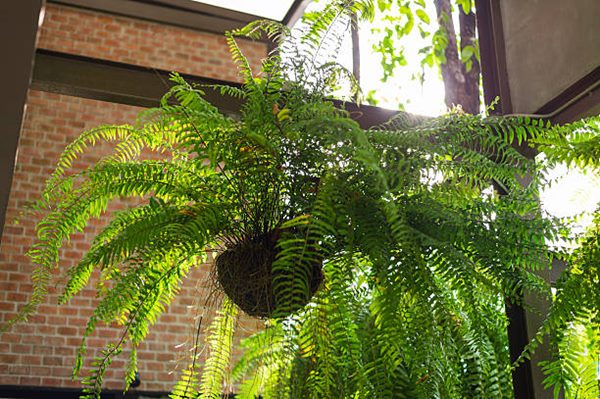How to Grow Sword fern in Pot | Boston fern Care in Pot
Learn how to grow Boston sword fern in pot by going through this post. Boston fern creates instant drama both in pot and hanging baskets.

Botanical Name: Nephrolepis exaltata
Common Names: Boston fern, Sword fern, Green lady, and Boston sword fern
USDA Zones: Hardy in zones 9 to 11 (Grown as houseplant North of zone 9)
Sword fern, also known as Boston fern, is a popular fern that makes a statement in the container. People confuse it with the western sword fern because of the same common name, but the Boston fern has a different appearance and characteristics. Sword-shaped foliage is made up of small leaflets arch and creates a dramatic effect when mature. Apart from the container, the Boston sword fern looks elegant in hanging baskets and containers with downward arching fronds. Learn how to grow Boston sword fern in pot by going through this post.
How to Grow Sword Fern in Pot

Boston sword fern hails from tropical regions, so growing it in the pot is ideal for temperature zones. High humidity and bright indirect light keep the plant healthy and growing. Sword fern prefers a well-draining potting mix based on peat moss and perlite. It dries out faster in the pot and requires regular fertilization once a month to replenish lost nutrients. Water regularly to keep the soil moist but do not overwater as it causes root rot. Stop fertilization and cut back watering in winters.
Propagating Boston Fern
It’s fairly easy to propagate sword fern by division and is the most preferred method of propagation. You can get the sword fern plant from the nursery or any online garden center if you don’t own the plant. Ferns do not produce seeds; rather, they bear spores which is another way you propagate Boston fern. To propagate Boston fern from division, follow the steps below.
- Carefully dig out the Boston fern from the container, ensuring not to damage the roots.
- Separate the plant using a garden trowel or shears to separate the fern section from the base with intact roots.
- Plant the divisions in new pots filled with well-draining potting mix.
- Keep the potting mix moist and locate the pot in bright indirect light.
- In 2-4 weeks, the fern will be established and soon start to show new growth.
Propagating Boston Fern from Spores: Collect the spores that fronds release in summer by placing a sheet of paper under mature fronds and shaking the fronds gently. Fill a pot with a good-quality organic potting mix that drains well. Sprinkle the collected fronds over the potting mix and mist over it. Cover the pot with a plastic sheet to elevate humidity and create a greenhouse-like effect. Locate the pot in a shaded spot away from direct sunlight. Mist regularly to keep the mix moist but never overdo it. Soon a thin green haze will form, which means the growth cycle of fern from sporophyte to gametophyte has started.
Choosing the Variety
There are many cultivars of Boston fern, but ideally, you should go for the compact cultivars for the container. Nephrolepis exaltata ‘Compacta,’ ‘Fluffy Duffy,’ ‘Florida Ruffle’ or a popular dwarf variety Lemon button fern are Boston fern types that do well in the pot. So before choosing a type of Sword fern, make sure that it’s well suited for the container.
Choosing the Container
Initially, choose a pot that’s 10-12 inches in diameter and depth so that the fern has enough room to grow. Ensure the pot has drainage holes at the bottom; if not, provide some. Go for a material that does not soak moisture, causing the potting mix to dry out faster. Plastic and glazed terracotta pots are perfect materials as they dry out slowly.
Location

The ideal place to locate sword fern is where it receives filtered light, be it a nearby window or porch. Direct sunlight in the morning is fine for mature plants, but the afternoon sun can scorch the leaves, whereas too little light causes poor growth and yellow fronds. You can also locate it on the balcony at a shaded spot or outdoors under the shade of a tree, shrub, or pergola. Growing the fern in hanging baskets in the bathroom and kitchen is also favorable due to high humidity levels.
NOTE: Boston fern is on the list of plants that purify the air as per the NASA clean air study, so placing it in a bright bedroom will keep the surrounding air free from pollutants.
Soil
Go for an organic potting mix that’s well-draining and formulated for containers. Check the label to see if the potting mix contains peat and perlite, as these two are markers of a good potting mix. Do not use garden soil for the container as it becomes compact after watering and can also be contaminated.
Watering
Water to keep the soil moist but not overwatered as it can lead to soggy soil and root rot. Check that the soil is dry a couple of inches below the surface before watering. Cut back watering in winters and fall to once every couple of weeks but do not let the fronds dry.
Temperature & Humidity
Normal room temperature ranging from 65 to 75 degrees F is ideal for the growth of Sword fern. Extremely high or low temperatures mean temperatures below 35 degrees F or above 95 degrees F will harm this fern. Like other ferns, Boston fern also thrives in high humidity levels above 80 percent. Mist around the fern or place a pebble tray filled with water near the base of the plant to raise humidity naturally.
NOTE: Frond tips turning brown is a sign of low humidity; in that case, take necessary measures to raise humidity.
Boston Fern Care in Pot

Fertilizer
Fertilize once a month using well-balanced houseplant fertilizer diluted half to its strength. Make sure to fertilizer only in the growing season and not in winters. Using fish emulsion or aged compost will also increase the nutrients in potting mix and aid in the growth of Boston fern.
Pruning
It’s vital to prune Sword fern regularly to promote bushier growth and prevent legginess. Trim the edges with a sharp pair of shears to keep the plant in the desired shape. Do not trim from the top; instead, go for side fronds growing at the base. Also, cut back the leafless runners and leaves that have turned brown.
Overwintering
When the fern becomes dormant in winters, bring it back indoors to the basement or any others spot protected from drafts. Cut back the fern before moving it indoors, or you’ll get a mess of fallen brown fronds on the carpet. Relocate the pot at a bright spot come spring and outdoors when the danger of frost has passed.
Pests & Diseases
Common garden pests such as whiteflies, mealybugs, and aphids can cause damage to the fronds, especially if you locate the pot outdoors. Give the plant a thorough wash under the sink faucet, shower, or bathtub to eliminate pests. Spraying neem oil or soap solution over the foliage also gets rid of such pests. Brown web-like mycelium over the plant’s foliage signifies blight, a fungal disease. Repot the fern in a new sterile pot filled with fresh potting mix and discard the parts of ferns affected with blight.





